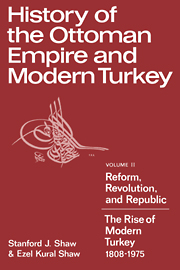Book contents
- Frontmatter
- Contents
- List of Tables
- Preface
- Preface to the second printing
- List of Abbreviations
- Note on Pronunciation
- Map of the Growth of the Ottoman Empire, 1280–1683
- Map of the Decline of the Ottoman Empire, 1683–1975
- 1 The Beginnings of Modern Ottoman Reform: The Era of Mahmut II, 1808–1839
- 2 The Era of Modern Reform: The Tanzimat, 1839–1876
- 3 Culmination of the Tanzimat: The Reign of Abdulhamit II, 1876–1909
- 4 The Young Turk Period, 1908–1918
- 5 The Turkish War for Independence, 1918–1923
- 6 The Turkish Republic, 1923–1975
- Appendix
- Bibliography: History of the Ottoman Empire and Modern Turkey, 1808–1975
- Index
6 - The Turkish Republic, 1923–1975
Published online by Cambridge University Press: 20 May 2010
- Frontmatter
- Contents
- List of Tables
- Preface
- Preface to the second printing
- List of Abbreviations
- Note on Pronunciation
- Map of the Growth of the Ottoman Empire, 1280–1683
- Map of the Decline of the Ottoman Empire, 1683–1975
- 1 The Beginnings of Modern Ottoman Reform: The Era of Mahmut II, 1808–1839
- 2 The Era of Modern Reform: The Tanzimat, 1839–1876
- 3 Culmination of the Tanzimat: The Reign of Abdulhamit II, 1876–1909
- 4 The Young Turk Period, 1908–1918
- 5 The Turkish War for Independence, 1918–1923
- 6 The Turkish Republic, 1923–1975
- Appendix
- Bibliography: History of the Ottoman Empire and Modern Turkey, 1808–1975
- Index
Summary
The Turks had won their independence, but a decade of war and revolution, massacre and countermassacre, banditry, blockade, and foreign occupation had decimated the population and shattered the economy of the lands that composed the new Turkey.
The Turkish Society and Economy in 1923
The disruption was massive. Most non-Muslims were gone, with the Greek community reduced from 1.8 million to 120,000 the Armenians from 1.3 million to 100,000. No less than 2.5 million Turks had died during the war, leaving a population of 13,269,606 in Anatolia and eastern Thrace. Foreign trade had fallen drastically, exports from 2.5 to 0.8 billion kuruş, imports from 4.5 to 1.4 billion kuruş between 1911 and 1923. State revenues declined from 2.87 to 1.8 billion kuruş, with the only consolation being that the dismantlement of the vast bureaucracy of Istanbul had left expenditures at 1.72 billion kuruş, providing a surplus for the first time in many years. The retail price index had skyrocketed from 100 in 1914 to 1279 in 1923, and prices were to continue rising during the remainder of the 1920s.
The years of sustained war effort followed by disastrous economic prospects might have led the nationalists of the young Republic to espouse an aggressive militaristic policy like that of the Young Turk leaders of the previous decade. Or they might have resorted to a highly nationalistic, revanchist, dictatorial regime, as in Nazi Germany, by harping on the misfortunes that had beset the nation. Instead, the Turkish Republic adopted a constructive policy based on a positive self-image and optimistic assessment of its future as a nation.
- Type
- Chapter
- Information
- History of the Ottoman Empire and Modern Turkey , pp. 373 - 437Publisher: Cambridge University PressPrint publication year: 1977
- 1
- Cited by



